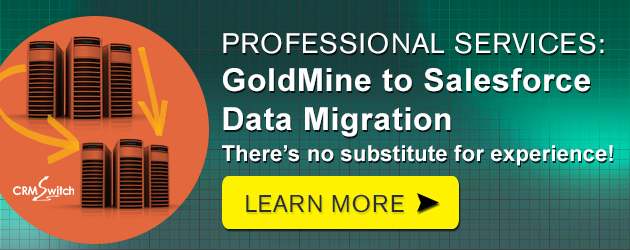We are often asked about GoldMine vs Salesforce.
GoldMine and Salesforce are both applications that were originally designed to help salespeople become more productive and ultimately sell more.
GoldMine has historically been a very popular contact manager among salespeople and has provided many business benefits to users and companies.

Salesforce came to market in 1999, years after GoldMine was initially released. Salesforce was developed with a very different design and delivery concept and has demonstrated a consistent pace of innovation. Here are some key differences between Salesforce and GoldMine Corporate and Premium Editions.
GoldMine vs Salesforce Comparison
1. Windows-Based vs. Web-Based
GoldMine Software Corp. was founded in 1989 when business use of the Internet was in its infancy. At the time of GoldMine’s initial launch, applications were almost exclusively designed to run as locally installed software on network PCs and on remote laptops that synchronized back to a main server.
Versions of GoldMine through the current release continue to be Windows-based and remote users still synchronize their data in many cases. The back-end database typically runs on an in-house server. GoldMine offers browser-based access via iGoldMine.
Salesforce does not require software to be installed and maintained. Salesforce is served up from redundant data centers in the “cloud”. All a user needs to access Salesforce is a Chrome, Firefox, or Safari browser. This means that it does not matter whether a user is on Windows, Mac, Linux, iOs, or some other platform. Extensive security measures, both physical and logical, keep data safe and protected.
Some end-users prefer Windows navigation over browser navigation, and management at some companies still prefer to run an application in-house vs. in the cloud.
2. Pricing Model
5 concurrent GoldMine user licenses can be purchased for $3,195. One year of support is included in this price. Each additional user is $695 + $139 support. There are volume discounts for 10 or more additional users. Concurrent users must be network users directly connected to the central database. Offline, synchronizing users must be named users—named user licenses are also. Customers must be current on software maintenance to be able to purchase new licenses and receive support. Customers are responsible for the cost of needed server hardware and software components.
Salesforce is priced as a per-user, per-month subscription. The monthly subscription fee ranges from $25 per user to $300 per user, depending upon which edition is deployed. Several of the Salesforce features referenced herein require the Enterprise Edition.
3. Software Upgrades
Most GoldMine customers upgrade GoldMine periodically to receive: support for new versions of Windows and MS Office, new features, and bug fixes. Upgrading GoldMine requires installing a new version of software on each user’s local PC and on remote user laptops or desktop machines.
Salesforce provides three major releases per year. These upgrades occur in the background. With minor exceptions, are seamless—they just happen. As with other cloud-based applications such as Google Workspace, this type of transparent upgrade allows for rapid innovation and does not come at any extra cost.
4. Contact-Centric vs. Account-Centric
Salesforce’s default mode is account-centric, the original design for business-to-business selling and customer interaction. As such, a user must first create an Account record for a company and then separately add Contact records under this Account record. Company data, such as “Industry”, lives in the Account record. Individuals’ information, such as “email address”, lives in the Contact record.
GoldMine is generally considered to be a contact-centric application. It does not have the concept of an Account (Company) record that Contacts are related to. Secondary Contacts can be added to a primary Contact record. However, users can only do a basic lookup on these Contacts. They can’t do any extended profiling of these Contacts, as custom fields are not available in the Secondary Contacts list. In addition, an organizational tree can be created to display related Contacts under a Company.
Here is some further insight into the differences between account-centric and contact-centric applications.
5. Flat File vs. Multi-Object Database Structure
GoldMine has a relatively flat database structure. There’s a main, Contact1 table with an accompanying one-to-one Contact2 table that together holds most data about companies and contacts. A secondary, one-to-many ContSupp table with a dozen or so text fields provides a level of relational capability. ContSupp is a multi-purpose table that can be used for secondary contacts and other data relating to a contact in a one-to-many fashion.
Salesforce has a multi-object database structure. Salesforce allows for adding custom fields to standard tables (objects in Salesforce parlance) and also allows for adding custom objects for a wide variety of purposes. For example, a custom object can be added to track: properties; inventory; installed products; warranties; or any other collection of records. Salesforce customers often consolidate many disparate databases (contact managers, Excel, Access, FileMaker, custom databases) into a single Salesforce database (called an “org”).
Here’s an example of how a given data set is managed in flat-file and multi-object databases.
6. Customization Tools
GoldMine has a design tool that lets an administrator add custom fields (date, text, or numeric) to the Contact2 table, which has a one-to-one relationship with the main, Contact1 table.
Salesforce provides point-and-click functionality for adding new fields to custom objects, creating new objects, and relating objects to one another.
Advanced customizations can be developed with Apex, Salesforce’s programming language, and with Visualforce, Salesforce’s markup language. A coder can create fully custom views and business logic within Salesforce.com to address specific business needs that can’t be handled with point-and-click design tools.
7. Security Model
GoldMine allows for both record-level security and field-level security. This means that an administrator can control access to specific data on a per-user basis. A record can be owned by everyone, a single user, or a group of users.
Salesforce provides several layers of data security. Profiles allow for defining record level and field level security. Sharing rules can grant more comprehensive access to data based on defined criteria. Territory Management is designed to handle even the most complex data security scenarios.
8. Sales Quoting
To create sales quotes associated with GoldMine Contacts, a third-party quoting application such as QuoteWerks or QuikQuote is needed.
Salesforce has embedded quoting functionality. Products are stored within the Salesforce database. Users can create Quotes within Opportunities and email quotes from within the Salesforce interface.
Discount rules can be set, and Quotes can be subjected to an approval process if necessary. Salesforce purchased CPQ vendor SteelBrick and offers that solution as CPQ & Billing.
9. Marketing Functionality
Traditional contact managers like GoldMine are good for “list marketing” as opposed to closed-loop marketing. Groups of contacts can be created based on various criteria. These groups can be mass-mailed or mass emailed.
Salesforce has several advanced marketing features and can be set up for closed-loop marketing. Campaigns can be created within Salesforce, and then emails can be sent to campaign contacts by integration with an Email Service Provider or Salesforce’s Marketing Cloud.
Salesforce also offers Pardot as a complete marketing automation solution.
10. Customer Support Features
GoldMine Premium Edition includes a customer support screen that allows users to log Cases and work on them. GoldMine has a VoIP phone module that includes IVR, call distribution with skills-based routing, quality management with Whisper Coaching, voice recording that can be attached to the history record, and more.
Salesforce leverages its cloud-based platform to support customer interaction via all major channels, including phone, Web, email, and social media.
Customers needing service or support can self-serve via the Self-Service portal or the full-featured Customer Portal.
11. Email Client Integration
Both GoldMine and Salesforce.com offer plugins for Outlook integration.
Salesforce also offers cloud-to-cloud integration with Outlook Online (Office 365) and Gmail (Google Workspace).
GoldMine has its own integrated email client, which many users swear by.
12. Reporting and Dashboards
GoldMine has an internal reporting tool with a set of pre-built reports. Contact filters can be created and used in reports. GoldMine comes with about 30 dashboards. These are interactive Dashboards, meaning a user can drill down from one graph to another graph or a grid for further analysis. A user can take various actions from a dashboard, including sending an email or letter to the group, scheduling a follow-up call, or creating a campaign for the group.
Salesforce comes with a large set of starter reports. A drag-and-drop interface lets users create their own reports and dashboards. Reports can be exported to a CSV file for further manipulation in Excel. A scheduler allows users to receive reports via email on pre-determined days and times.
13. Mobile Access
An iOS client for GoldMine is available directly from GoldMine. Third-party products are also available.
Salesforce offers apps for iOS and Android. Custom mobile solutions can be built on top of the Salesforce Mobile Platform.
14. Employee Collaboration
Salesforce has an enterprise social networking functionality called Chatter. Chatter allows for sharing of information within an organization and provides a way for employees to discuss opportunities, service cases, projects, and more — outside the boundaries of structured data.
15. Third-Party Applications
GoldMine has spawned a cottage industry of third-party add-on products, as with many software applications for business. Many of these are indexed in a third-party add-on store.
Salesforce took the approach of creating its own centralized marketplace for third-party solutions—the AppExchange. These applications all have to go through an annual security review. Some AppExchange applications are free, and some are paid for. Most of them can be installed into a company’s Salesforce org with just a few clicks.
Included among hundreds of AppExchange applications are integrations with DocuSign’s eSignature solution, Conga Composer’s document merging, and a native accounting application called AccountingSeed.




